Sign Shop Profile: RP Graphics Group
by all | 13 June 2014 1:30 pm
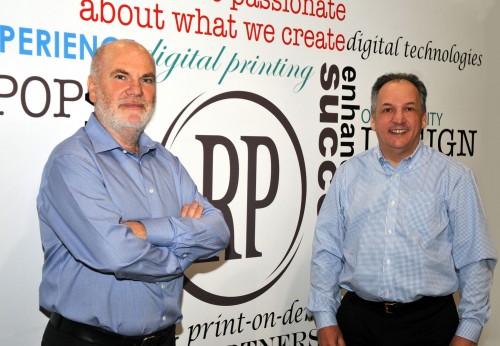 [1]
[1]Pictured left to right are George Mazzaferro, founder and CEO, and Marc Fortier, president. Photos courtesy RP Graphics Group
By Peter Saunders
In recent years, there has been much industry talk about opportunities for commercial printing firms to achieve new revenue streams by adding wide-format inkjet presses to their production departments. Few Canadian companies have been as successful in this respect as RP Graphics Group in Mississauga, Ont., and it has taken much more than simply the acquisition of new machines.
Commercialized and digitized
Roma Printing was founded in 1958 as a small, two-person shop on Toronto’s Eglinton Avenue. When current CEO George Mazzaferro and two business partners bought the company from its retiring owners in 1978, the shop was using a Heidelberg Windmill press to produce small-format output, including invoices and wedding invitations, primarily for the Italian-Canadian community.
Mazzaferro—then just 20 years old, but with eight years’ experience and a technical school education in the printing industry—began to lead an expansion into broader commercial production capabilities. His partners left the business in the early 1980s.
The company was renamed RP Graphics Group in 1991 and became an early adopter of digital printing technologies, including a Heidelberg Quickmaster Direct Imaging (DI) press in 1995, which allowed the company to transfer images and text onto a variety of paper stocks without needing camera work, film development, assembly and other traditional intermediate steps.
“Back in the ‘90s, we were the first printer in Canada to integrate digital capabilities as part of our product offering,” says Mazzaferro.
The business moved into its current 5,574-m2 (60,000-sf) building in 2005.
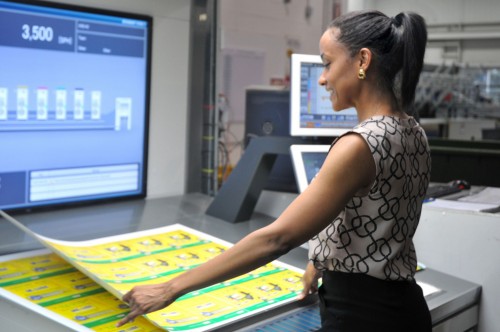 [2]
[2]As RP Graphics specializes in promotional marketing for retailers and other clients, it has expanded its wide-format division.
Thinking big
In 2007, RP entered the large-format printing market by establishing a new department with its first Inca Digital Spyder ultraviolet-curing (UV-curing) flatbed press from Fujifilm Canada Graphic Systems. A second followed in 2008 with white ink, along with a Zund digital cutter. These were accompanied by expanded finishing and kitting services in 2010.
“Large-format was a perfect fit for us,” says Mazzaferro. “One of our major customers, a retailer carrying multiple brands, was already buying large-format point-of-purchase (POP) graphics from another vendor. I knew we could sell to them and I saw this as an opportunity to grow. We ended up doubling our sales to that customer.”
RP had already built a reputation for highly customized work, which helped ease the transition of adding POP graphics to its diversified portfolio.
“We never put all of our eggs in one basket,” says Mazzaferro. “As we saw a decline in the litho world, with a lot of book printing moving overseas, POP made sense: when customers need it, they need it tomorrow. And as our salespeople learned more about these graphics, they managed to raise customer demand.”
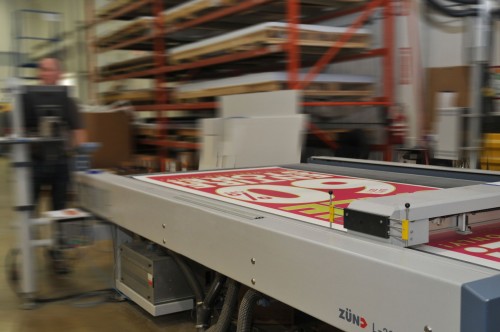 [3]
[3]After installing its first two flatbed presses, RP added a digital cutter in 2008.
By 2011, RP increased capacity further with the addition of a Jeti Titan wide-format printer from Agfa Graphics. This acquisition marked the beginning of an ongoing relationship with Agfa, whose Canadian headquarters (HQ) and Titan manufacturing facilities are right across the street from RP’s main office.
Since then, RP has beta-tested a variety of Agfa presses, including a second Titan and, most recently, an M-Press Leopard (see Sign Media Canada, April 2014, page 16[4]), which was installed earlier this year to help RP compete with screenprinting companies in targeting higher-volume jobs. In 2013, the relationship was formalized with the signing of a ‘partner for development’ strategic agreement.
Under this agreement, technological developments are discussed and scheduled before equipment is tested in a live production environment under specific conditions. RP and Agfa share the costs involved.
The relationship has been highly symbiotic. RP’s expansion into wide-format graphics is mirrored in the current strategies of Agfa, which has set a goal of becoming one of the top printer manufacturers for the sign and display industry in the future.
RP has also grown in “scale and scope,” as Mazzaferro puts it, through acquisitions of other printing companies. In 2012, for example, RP purchased the outstanding shares of variable data printing (VDP) and specialty finishing company Data in Motion Marketing, which expanded in-house capacity for producing direct mail.
Mazzaferro explains such acquisition efforts are focused on gaining new staff, expertise and customer lists, but they can also add production capabilities in noteworthy ways. In 2013, for example, when RP acquired Canadian Impact Imaging’s large-format business in Mississauga, it picked up a Durst Rho 800 continuous-board UV-curing flatbed printer and related finishing equipment.
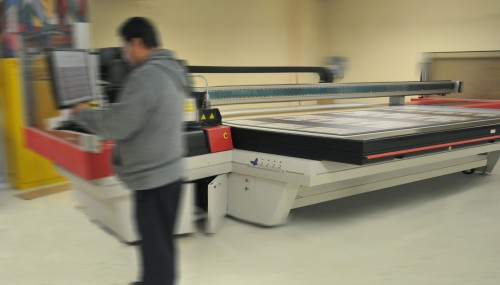 [5]
[5]Under a special business partnership with Agfa Graphics, whose Canadian offices are right across the street, RP has beta-tested Jeti Titan and other printers.
Sharing leadership
In the midst of RP’s expansion into large-format printing, another major change was the addition of Marc Fortier as president in June 2012. Like Mazzaferro, Fortier was well-known within the Canadian graphic arts industry for bridging the gap between traditional and emerging digital printing technologies. While they are both entrepreneurial, however, their skills also complement each other, as Mazzaferro is more sales-oriented and Fortier’s expertise is in organizing business processes and structural management.
“George and I met 10 years ago and became friendly competitors,” says Fortier, who served as an executive with Transcontinental Yorkville Printing and PLM Group. “We backed each other up when we faced challenges. He was always very generous in sharing equipment knowledge and information about the industry. Eventually, we talked about working together.”
“I had my hands on everything until Marc came in,” says Mazzaferro. “We had gotten to a certain size where things were becoming difficult. I brought him in to take the company to the next level with his management experience. Now I can oversee the direction of the business without having to worry about day-to-day operations.”
As president, Fortier set about finding efficiencies between various departments that had previously operated independently. This had become increasingly important as RP expanded.
“We’ve integrated our strengths,” says Fortier. “We’ve been G7-certified for colour management by the International Digital Enterprise Alliance (IDEAlliance), for example, as we’re ensuring colour consistency across all platforms.”
Earlier this year, Fortier also became a part-owner of RP.
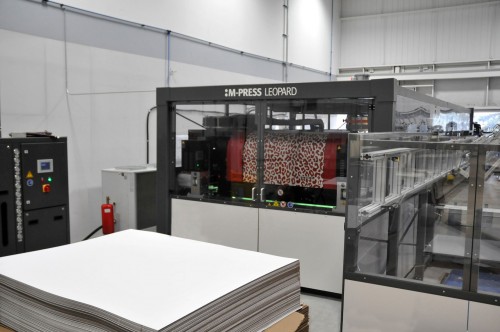 [6]
[6]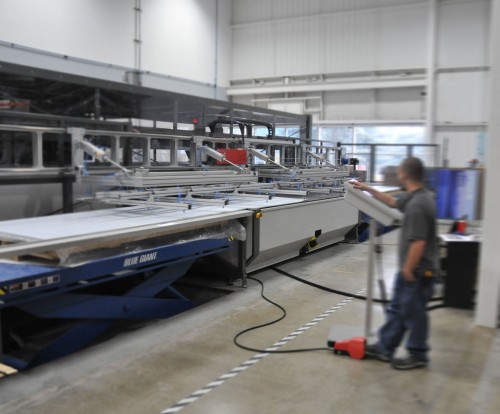 [7] The company’s most recent wide-format addition is an M-Press Leopard four-colour flatbed inkjet printer.
[7] The company’s most recent wide-format addition is an M-Press Leopard four-colour flatbed inkjet printer.
Completing the picture
Today, RP has a dedicated staff of 108 employees across two facilities in Mississauga. The main building, dedicated to manufacturing, is supported by a 1,022-m2 (11,000-sf) warehousing and distribution centre—Canadian Impact Imaging’s former facility—a few blocks away.
“We’ve spent considerable money over the past two years on new equipment,” says Fortier. “You need to stay on top of technology all the time in this industry. That said, it’s not just about buying a printer. You need to dedicate yourself to understanding the market.”
Mazzaferro and Fortier describe RP as a fully integrated print service provider (PSP), specializing in promotional marketing, large-format digital printing, direct mail and print-on-demand applications. Clients’ multi-component projects may start at the creative engineering stage, then move on to production—i.e. lithographic, digital or large-format printing—in all of the manufacturing departments, followed by finishing, bindery, kitting and/or fulfilment.
Within this mix, large-format is the fastest-growing division. And in the next three years, Mazzaferro predicts it will become the company’s largest source of revenue.
“Our goal is to make better use of our current roster of services,” he says. “Our biggest advantage is being able to do everything in-house, which means we can be quick. We have the equipment and we can run more shifts when we need to.”
“We’re a one-stop shop, but only in support of our core competencies,” says Fortier. “We can handle full POP campaigns, printing posters, banners and shelf talkers, kitting them and shipping them, all from under one roof. There’s not a lot we can’t do.”
- [Image]: http://www.signmedia.ca/wp-content/uploads/2014/05/George_Marc.jpg
- [Image]: http://www.signmedia.ca/wp-content/uploads/2014/05/press_approval.jpg
- [Image]: http://www.signmedia.ca/wp-content/uploads/2014/05/digital_cutter.jpg
- 16: http://www.kenilworth.com/publications/smc/de/201404/files/16.html
- [Image]: http://www.signmedia.ca/wp-content/uploads/2014/05/Titian_large_format_printer.jpg
- [Image]: http://www.signmedia.ca/wp-content/uploads/2014/05/Leopard_large_format_printer1.jpg
- [Image]: http://www.signmedia.ca/wp-content/uploads/2014/05/Leopard_large_format_printer.jpg
Source URL: https://www.signmedia.ca/shop-talk-sign-shop-profile-rp-graphics-group/